DARIN LAHOOD SHARES THE MOST REWARDING PART OF HIS JOB: “Getting to help people every day in Illinois.”


DARIN LAHOOD SHARES THE MOST REWARDING PART OF HIS JOB: “Getting to help people every day in Illinois.”

The United States has fewer physicians than virtually every other developed country. That is a policy choice we can fix.
by ROBERT ORRPLUS: Protecting the Doctor-Patient Relationship.
 by MICHAEL C. BURGESS, M.D.
by MICHAEL C. BURGESS, M.D.
AND: We Are Not Ready for the Next Pandemic. That’s A Choice.
by CAROLYN REYNOLDSEach year, America's hospitals and health systems:
• Provide care to all who need it
24 hours a day



7 days a week

365 days a year
• Deliver 3.5 million babies



• Care for 31 million people admitted to hospitals






















• Employ 6.5 million people



























• Provide emergency care for 123 million people






Throughout a once-in-a-century pandemic, hospitals and health systems exhibited compassion , courage and commitment to serving patients and communities .

4 Breaking Point
By Robert OrrThe United States has fewer physicians than virtually every other developed country. The vast bulk of the blame lies with the bottlenecks in our training and education pipeline.
7 Protecting the Doctor-Patient Relationship
By Michael C. Burgess, M.D.The doctor-patient relationship is the cornerstone of America’s health care system, and it distinguishes our high-quality care from the rest of the world.
8 We Are Not Ready for the Next Pandemic. That’s A Choice.
By Carolyn ReynoldsHundreds of Americans are still dying each day from COVID-19, while the next pandemic could strike at any time. In many ways we are even less prepared than before COVID-19.
Politics & Perspective
10 Not Accountable
By Caroline BanaszakIn his latest book, Philip Howard argues that government has become so dysfunctional because public employee unions, as opposed to elected officials, have too much control.
12 Keys to a Successful Congress
By Michael JohnsonExpectations are low that Republicans and Democrats can get anything done in the House, but new leadership on both sides of the aisle offers hope for some bipartisan cooperation.
Editor Lou ZickarPolitics & Perspective (cont’d)
15 Our Laboratories of Democracy can Improve the Republic
By John PudnerRepublicans often resist change for change’s sake. But the party should keep an eye on what is happening in Alaska and Nevada and consider how other states approach elections.
17 A Mechanism to Reduce Spending that Joe Biden Used to Support
By Lou ZickarThe President once supported a version of sunset legislation that was approved by the U.S. Senate. With Congress nearing a fiscal cliff, Republicans should see if he would support it again.
Debate: Should Section 230 be Repealed?
20 Don’t Repeal the Law That Created the Internet
By Berin SzókaWithout Section 230’s protections, both providers and users of “interactive computer services” could be sued as the “publisher” of content they didn’t create.
21 Section 230 is a Counter-Productive Law that Makes Big-Tech Unaccountable
By Scott ClelandAs the internet matured, this policy resulted in many unintended consequences, from loss of privacy to abuse of minors to the extreme polarization of the American electorate.








U.S. Senators:
Shelley Moore Capito (WV) – Senate Co-Chair
Todd Young (IN) – Senate Co-Chair
Marsha Blackburn (TN)
Bill Cassidy, M.D. (LA)
Susan M. Collins (ME)
Steve Daines (MT)
Joni Ernst (IA)
Deb Fischer (NE)
John Hoeven (ND)
Jerry Moran (KS)
Mike Rounds (SD)
Thom Tillis (NC)
Roger Wicker (MS)
U.S. Representatives:
Larry Bucshon, M.D. (IN) – House Co-Chair
Frank Lucas (OK) – House Co-Chair
Mike Kelly (PA) – Vice Chair
Dan Newhouse (WA) – Vice Chair
Ann Wagner (MO) – Vice Chair
Mark Amodei (NV)
Kelly Armstrong (ND)
Don Bacon (NE)
Troy Balderson (OH)
Andy Barr (KY)
Stephanie Bice (OK)
Mike Bost (IL)
Vern Buchanan (FL)
Michael C. Burgess, M.D. (TX)
Ken Calvert (CA)
Buddy Carter (GA)
Tom Cole (OK)
John Curtis (UT)
Tom Emmer (MN)
Ron Estes (KS)
Brian Fitzpatrick (PA)
Randy Feenstra (IA)
Andrew Garbarino (NY)
Kay Granger (TX)
Garret Graves (LA)
Sam Graves (MO)
French Hill (AR)
Bill Huizenga (MI)
Bill Johnson (OH)
Dusty Johnson (SD)
Dave Joyce (OH)
John Joyce, M.D. (PA)
Young Kim (CA)
Darin LaHood (IL)
Bob Latta (OH)
Nancy Mace (SC)
Brian Mast (FL)
Kevin McCarthy (CA)
Michael McCaul (TX)
Carol Miller (WV)
John Moolenaar (MI)
Blake Moore (UT)
Guy Reschenthaler (PA)
Cathy McMorris Rodgers (WA)
Steve Scalise (LA)
Adrian Smith (NE)
Lloyd Smucker (PA)
Pete Stauber (MN)
Bryan Steil (WI)
Glenn “GT” Thompson (PA)
Mike Turner (OH)
David Valadao (CA)
Brad Wenstrup, D.P.M. (OH)
Steve Womack (AR)
With our nation approaching the third anniversary of the COVID-19 lockdown, the latest edition of The Ripon Forum examines the state of pandemic preparedness in America and the fact that our country has fewer doctors per capita than virtually every other developed country in the world.
Leading the Forum’s coverage is Robert Orr of the Niskanen Center, who, in an essay entitled “Breaking Point,” assesses the shortage of physicians in the U.S. and explains why it is a problem that can and should be fixed. “Doctors are increasingly reporting being overworked and burned out at the same time that Americans are increasingly reporting supply-related barriers to accessing care,” Orr writes. “Why do we have so few doctors? The vast bulk of the blame here lies with the substantial bottlenecks in our training and education pipeline.”
“The United States should pursue policies aimed at substantially boosting the number of physicians. Many highly capable young Americans would like to practice medicine. We simply have to let them. Achieving this would involve investing in the creation of additional medical schools, restructuring residency funding to better support the nation’s health needs, and experimenting with strategies to offer a streamlined medical degree pathway that’s more in line with the rest of the developed world.”
In another essay, U.S. Rep. Michael Burgess (TX-26) examines another challenge facing doctors today — administrative paperwork. “Prior authorization is a process in which a physician gets permission by an insurance company prior to performing a service,” writes Burgess, who spent nearly three decades practicing medicine prior to his election to Congress in 2003. “From personal experience, it is incredibly troubling to me that administrative responsibilities could block patient access to treatment. What is the value of developing a relationship with your patient if the insurance company or the government is going to tell you how to treat your patient?”
A shortage of health care professionals is not the only challenge facing America as it approaches the third anniversary of the COVID-19 lockdown. According to Carolyn Reynolds, Co-Founder of Pandemic Action Network, as the country attempts to move beyond the current pandemic, it is also remarkably unprepared for the next one. “Burned out health workers have left the profession in droves, leaving massive staffing shortages,” Reynolds writes. “Health systems everywhere have been stretched to the max, especially in the most vulnerable communities and countries. Disinformation, distrust of public health authorities, and vaccine hesitancy are at all-time highs, with fewer people willing to adhere to public health measures that can stop pandemics from spreading.”
“We must treat pandemic preparedness with the same sustained level of priority, planning, investment, and innovation as we do our military and economic defenses - to ensure we are always ready for the next threat. Outbreaks will continue to happen, but letting them turn into pandemics is a costly political choice. No one wants to go back to March 2020, so let’s make the smart choice to invest now in pandemic preparedness. That is something both sides of the aisle should agree on.”
In addition to examining America’s preparedness for the next pandemic, the latest edition of the Forum also features our Deputy Editor Caroline Banaszak’s review of Not Accountable, a new book written by attorney and good government expert Philip Howard about the power of public employee unions and how it has helped fuel government dysfunction. Veteran House leadership aide Mike Johnson takes a look at the 118th Congress and finds reason to hope that leaders on both sides of the aisle will find common ground in the coming year. John Pudner of Take Back Our Republic examines some of the election reforms being implemented in states across the country and explains why Republicans should pay particular attention to what’s taking place in Alaska and Nevada. In a piece written by me, I look back at the President’s past support of sunset legislation as a member of the Senate, and argue that, with Congress nearing a fiscal cliff, Republicans should see if he would support similar legislation again.
In our debate feature, Berin Szóka of TechFreedom and Scott Cleland of the Restore Us Institute square off over the question of whether Section 230 of the 1996 Communications Decency Act should be repealed. And in our latest Ripon Profile, U.S. Rep. Darin LaHood (IL-16) discusses the toughest, and most rewarding, parts of his job.
As always, we hope you enjoy this latest edition of The Ripon Forum, and encourage you to contact us with any questions or comments you may have.
Lou Zickar, Editor of The Ripon Forum louzickar@riponsociety.orgThe United States has fewer physicians

than virtually every other developed country. That is a policy choice we can fix.
by ROBERT ORRThe United States has fewer physicians per capita than virtually every other developed country. At first glance, our lack of physicians is a puzzle.
The demand for doctors’ services is certainly there. Doctors are increasingly reporting being overworked and burned out at the same time that Americans are increasingly reporting supply-related barriers to accessing care . It’s also not because financial incentives are lacking either. American doctors remain exceptionally well compensated , both relative to other U.S. professions as well as compared to doctors in other countries.
All of this raises the question: why do we have so few doctors? The vast bulk of the blame here lies with the substantial bottlenecks in our training and education pipeline.
The difficulties here start with medical school. Apart from Canada, the United States is the only wealthy country requiring prospective doctors to earn a separate four-year bachelor’s degree prior to entering a four-year medical school. A single six-year medical degree is the norm in other countries. Our more cumbersome approach to educating physicians was a response to the perceived backwardness of American medicine in the years following the Civil War. State-driven efforts to regularize medical practitioners around a scientific curriculum clashed with America’s laissez-faire attitudes. This uneven practitioner quality posed a difficulty for philanthropists looking to emulate the medical advancements emerging out of Europe’s hospital-integrated research universities.
In attempting to import this model to America with the establishment of Johns Hopkins University, it was decided that medical school enrollment would be limited to those with a prior academic degree to compensate for the deficiencies of America’s practitioner workforce. In the decades that followed, Hopkins established itself as perhaps the most prestigious medical school in the country. With the 1911 Flexner Report’s designation of Hopkins as the model to conform to, the two-degree approach was copied along with the rest of the package, effectively rolling it out as the standard across the country.
While gatekeeping medical education behind a bachelor’s degree may have been a sensible response to the conditions of the time, it has increasingly
become a liability. Having to spend eight years in school rather than six years means starting one’s medical career at an older age and having less time to spend before retirement age. Two additional years of school translates into two more years worth of tuition to pay. The vast majority of doctors emerge from medical school with an enormous debt burden, typically totaling about $200,000 .
Given the American system’s clear negatives, nobody would argue this is the most efficient or effective way to educate physicians. Much of the course content in obtaining a four-year bachelor’s degree is irrelevant to medical practice. Indeed, even undergraduate coursework in subjects such as biology that are medically relevant would be better delivered as part of an integrated program.
It’s always hard to change long-established ways of doing things, even when they are clearly inadequate. But it’s particularly difficult to change when competition to get into medical school among Bachelor’s Degree holders remains as fierce as it is, heightened following restrictions on medical school enrollment during the 1980s.
The problems stemming from our less efficient approach to educating doctors were compounded due to actions taken in response to an ill-conceived government report in the 1980s warning of an imminent “physician surplus.” Released in 1981, the Graduate Medical Education National Advisory Committee (GMENAC) report concluded that the United States was on the verge of a massive physician surplus, recommending immediate action to curtail both the domestic training of physicians as well as the admittance of those trained outside of the country.
In response to the report, medical schools established a 25-year voluntary moratorium on new schools . Similarly, in line with the GMENAC’s recommendations, medical schools either froze or cut student enrollment. Four years after the moratorium commenced, the number of medical graduates peaked and then began to decline modestly. Annual entrants to M.D.-granting schools fell in absolute terms from 16,600 in 1981 to a low of 15,800 in 1989. M.D. enrollment would not match its previous high until the moratorium ended in 2005.
While medical school enrollment is once again expanding, it remains far below what it would’ve been if pre-1980 enrollment growth trends had continued.
Doctors are increasingly reporting being overworked and burned out at the same time that Americans are increasingly reporting supply-related barriers to accessing care.
And while foreign and Osteopathic graduates helped to soften the blow, we are still digging ourselves out of a physician shortfall that we engineered
The other major legacy of the “physician surplus” was the gradual withdrawal of financial support for residency training. Following graduation from medical school, doctors spend at least three to seven years in residency training, depending upon which specialty they pursue.

Similar to medical school, undergoing residency training through an accredited program is essential to becoming a licensed physician. Unlike medical school, student loans are not available to finance this training. Instead, residencies are financed through a combination of labor contributed to the teaching hospital by the residents themselves as well as government support, the vast majority of which is provided through Medicare.
This culminated in the freeze on Medicare-funded residency training slots enacted by Congress in 1997 The impact of this policy was not only to make it more difficult for new residency positions to break even from the teaching institution’s standpoint, but also to fix an uneven geographical distribution of funding for residency training across the United States. As the U.S. population has grown less concentrated in high-cost states of the Northeast, the mismatch between medical demand and where doctors are trained has increased
On a per-person basis, New York receives six times more Medicare funding for residency training than Georgia despite training only three-and-a-half times as many residents . A geographically uniform funding structure would be both fairer and more costeffective, allowing doctors to train in places with greater unmet demand.
With the benefit of hindsight, it’s clear that restricting physician supply harms patient access without controlling health care costs. The greatest casualty of these bottlenecks has been primary care. The mismatch between the demand for medical services and the supply of physicians capable of delivering them has resulted in the physician workforce we do have being overwhelmingly prioritized towards procedural care.
In order to redress past mistakes, the United States should pursue policies aimed at substantially boosting the number of physicians. Many highly capable young Americans would like to practice medicine. We simply have to let them. Achieving this would involve investing in the creation of additional medical schools, restructuring residency funding to better support the nation’s health needs, and experimenting with strategies to offer a streamlined medical degree pathway that’s more in line with the rest of the developed world. RF
Apart from Canada, the United States is the only wealthy country requiring prospective doctors to earn a separate four-year bachelor’s degree prior to entering a four-year medical school.
Robert Orr
“Ideas that matter, since 1965.“
Many health care practices we consider essential are slowly becoming things of the past or recent memory. Frighteningly, the most critical component of our health care system – the doctor and patient relationship – is on the verge of joining this list.
Prior to coming to Congress, I served the moms and babies of North Texas for nearly 30 years. Patients and their doctors should be dictating treatment and care plans that are right for them, not the insurance companies and certainly not the federal government. The doctor-patient relationship is the cornerstone of America’s health care system, and it distinguishes our high-quality care from the rest of the world. To me, this is personal. My dad, a doctor and surgeon, left Canada’s socialized system of medicine to escape the restrictive control over the practice of medicine.
In my meetings with physicians and health care providers, I have heard the unending concerns that our health care system focuses more on the art of paperwork than on time spent with patients. Prior authorization is a process in which a physician gets permission by an insurance company prior to performing a service. This process ensures that physicians are prescribing the most appropriate treatment plan, arguably an important goal. The system’s complexity, however, has added unnecessary layers of bureaucracy that have resulted in lost time, limited resources, and significant delays in care. Policies like prior authorization drive a wedge between doctors using their professional judgment and patients receiving quality care.
An ingenious idea came to me during a meeting I took last Congress with several Texas physicians who informed me of a new concept known as “gold carding” that the Texas legislature recently passed in the state. This law allows a physician who receives a 90% prior authorization approval
rate over a 12-month period for certain services to be granted a “gold card” that would exempt them from prior authorization requirements. The gold card creates a gold standard for doctors: if they’re practicing at a high level of quality, they can cut out the burdensome paperwork.
A recent American Medical Association (AMA) survey found that physicians and staff spent more than 16 hours each week completing prior authorization requirements to get patients necessary medicines, medical services, or essential procedures. On an annual basis, the survey concluded that 853 hours are spent on prior authorization tasks. The likely result is delayed patient care, often for months at a time.
Further, in another survey, the AMA questioned over 1,000 physicians on prior authorization policies, with 79% saying that prior authorization sometimes even leads to treatment abandonment. From personal experience, it is incredibly troubling to me that administrative responsibilities could block patient access to treatment. What is the value of developing a relationship with your patient if the insurance company or the government is going to tell you how to treat your patient? Did they go to medical school?
Fixing the prior authorization process is critical to streamlining efficiency and encouraging value in our health care system. For this reason, I am championing the GOLD CARD Act in the House of Representatives. This legislation would exempt providers who received approval for 90% of their requests in the last 12 months from prior authorization delays for Medicare Advantage beneficiaries. Additionally, the GOLD CARD Act would allow physicians to appeal an attempt by a Medicare Advantage plan to rescind the exemption.
One of the core principles of value-based care is that providers should be rewarded for their quality of care. The concept of rewarding high performance is not new to health care. Adopting a “gold carding” policy would allow our health care system to transition towards a value-based care system while preserving the doctor-patient relationship.
This foundation sets America apart and makes our medical care the best in the world. RF
Dr. Michael Burgess spent nearly three decades practicing medicine in North Texas before being elected to Congress in 2003. He serves on the House Rules Committee as vice chairman, Energy and Commerce Committee, and Budget Committee.

In my meetings with physicians and health care providers, I have heard the unending concerns that our health care system focuses more on the art of paperwork than on time spent with patients.
Remember March 2020, when our world changed overnight and our businesses, schools, and social lives shut down due to a novel, deadly, and fast-moving virus? As we mark the third anniversary of the COVID-19 pandemic, it all seems like a distant bad dream: masks are off, boosters sit unused, free tests and treatments will soon end. After more than one million lives lost and $14 trillion in U.S. taxpayer funds for the COVID response, Americans have put the pandemic squarely in the rear-view mirror and have determined the threat is over.
The problem: Hundreds of Americans are still dying each day from COVID-19, while the next pandemic could strike at any time – and be much more deadly. In many ways we are even less prepared than before COVID-19. Burned out health workers have left the profession in droves, leaving massive staffing shortages. Health systems everywhere have been stretched to the max, especially in the most vulnerable communities and countries. Disinformation, distrust of public health authorities, and vaccine hesitancy are at all-time highs, with fewer people willing to adhere to public health measures that can stop pandemics from spreading. COVID-19 also exposed systemic failures due to years of neglect and underinvestment in pandemic preparedness, ignoring experts’ warnings. The pandemic itself became politicized, subjecting the response and future-thinking efforts to partisan squabbling instead of taking bold action to address an existential threat to our health, economy, and security.
and International Pandemic Prevention and Response Act and the PREVENT Pandemics Act. Taken together, they rightly elevate and codify pandemic preparedness as a priority for domestic and global health, and for national security. They direct the Executive Branch to make structural leadership changes, including establishing a new Office of Pandemic Preparedness and Response Policy and a U.S. Coordinator for Global Health Security at the White House. In parallel and consistent with the GHS Act, Secretary of State Antony Blinken announced his intent to create a new Bureau of Global Health Security and Diplomacy at the State Department under the leadership of Ambassador John Nkengasong, the current U.S. Global AIDS Coordinator.
Carolyn Reynolds
In line with the new National Biodefense Strategy, the PREVENT Act authorized the Advanced Research Projects Agency for Health (ARPA-H) within the National Institutes of Health. This and other provisions in the bill aim to accelerate research, development, and manufacturing of new countermeasures to address emerging disease threats.
Both bills increase Congressional oversight of the federal government’s pandemic readiness plans. They also authorize increased spending at home and abroad to bolster pandemic preparedness and response, including for the U.S. contribution to the newly established Pandemic Fund at the World Bank to help lowand middle-income countries bolster their capacity to detect, prevent, and respond to potential pandemics.
There is some good news. In its final days, the 117th Congress passed two significant pieces of legislation with strong bipartisan support: the U.S. Global Health Security
These are welcome steps, but they are insufficient to meet the scope of the challenge. Here are four things the U.S. government should do to ensure America and the world are better prepared for the next pandemic threat:
We must treat pandemic preparedness with the same sustained level of priority, planning, investment, and innovation as we do our military and economic defenses - to ensure we are always ready for the next threat.
Approve the funding. Congress has authorized spending increases, but appropriators need to act. The President’s Fiscal Year 2023 Budget Request included $88 billion in new mandatory funding to strengthen domestic and global preparedness, including $4.5 billion over 5 years for the Pandemic Fund. Congress largely ignored the request. The Biden Administration needs to go at it again in its soon-to-be-released FY24 budget, and this time forge a bipartisan deal with Congressional leaders to make this a must-pass priority, in addition to current spending.
Bridge the domestic-global divide. Pandemics are global threats with national and local impacts. The delays in making COVID-19 vaccines accessible globally have caused the spread of new variants and prolonged the pandemic here. Congress must dispense with limited thinking that divides global and domestic policy. Along with bolstering our domestic public health, research and development capabilities, U.S. support for global efforts like the Coalition for Epidemic Preparedness Innovations (CEPI) and a pandemic countermeasures platform serve American interests by accelerating access to tools to help stop outbreaks where they happen. .
Strengthen our global institutions. A stronger World Health Organization with the mandate and resources to investigate emerging outbreaks and foster rapid data sharing among countries is a vital part of our pandemic arsenal.
Similarly, the International Monetary Fund and multilateral development banks could do much more to tackle the global threats of pandemics and climate change. Treasury Secretary Janet Yellen has urged other nations to agree on a package of World Bank reforms this year, and Congress should offer its full support.
Change our mindset. Pandemics are not just a health issue. COVID has impacted every aspect of our lives and economy. We must treat pandemic preparedness with the same sustained level of priority, planning, investment, and innovation as we do our military and economic defenses - to ensure we are always ready for the next threat.
Outbreaks will continue to happen, but letting them turn into pandemics is a costly political choice. No one wants to go back to March 2020, so let’s make the smart choice to invest now in pandemic preparedness. That is something both sides of the aisle should agree on. RF

Carolyn Reynolds is Co-Founder of Pandemic Action Network, a global coalition of more than 350 organizations driving collective action to address the COVID-19 crisis and ensure the world is better prepared for the next pandemic. She is also a Senior Associate (non-resident) at the Center for Strategic and International Studies.

Shortly after Republicans won control of the U.S. House of Representatives in 1994, a book was published that soon became a must-read on every Republican’s reading list.
It was called The Death of Commonsense: How Law is Suffocating America. Written by attorney Philip K. Howard, the book offered a detailed look at how overregulation and bureaucratic overreach were stifling innovation and free enterprise in America.
Nearly 30 years later, with the GOP once again back in control of the House, Howard is out with another book that should not only once again be at the top of every Republican’s reading list, but should be on the reading list of any American who wants a more effective government and supports eliminating the obstacles that stand in the way of achieving that goal.
The book is called Not Accountable: Rethinking the Constitutionality of Public Employee Unions. As its name implies, Howard believes one of the reasons that government has become synonymous with dysfunction is because public employee unions – as opposed to elected officials – have too much control. He offers a searing indictment detailing, in his words, “how public employee unions have disabled democratic governance in five principal ways.”
Howard writes that “public employee unions have:
1) Severed the links of accountability;
2) Rendered government substantially unmanageable with detailed rules and veto powers;
3) Made government unaffordable with opaque benefit packages and compensation manipulations;
4) Changed public policies to the harm of the public good; and,
5) Entrenched these abuses, and made reform practically impossible, through organized political power.”
Like he did in The Death of Common Sense three decades earlier, Howard fills Not Accountable with strong examples to
support his argument – examples in this case which highlight how the principles of democratic governance have taken a backseat to the drive by public unions to gain more power and control.
“In 1994,” he writes, citing one example, “the California Correctional Peace Officers Association (CCPOA) organized a coalition to pass a referendum for a ‘three-strikes’ law mandating twenty-five-years-to-life sentence for people on their third crime, even if it’s nonviolent. By increasing the number of inmates, the law thereby expanded the need for more correctional officers.” Howard goes on to point out that: “the unionsponsored law had the desired effect –the California state prison population rose from roughly 50,000 in 1985 to 170,000 in 2006. So did the number of CCPOA members, from 5,000 to 31,000. So did the compensation of prison guards – to a pay scale roughly twice that in other states.”
Howard also notes that public employee unions have played a leading role opposing taxpayer initiatives to limit spending and taxes. He cites research by political scientist Daniel DiSalvo, who reported that in 2009: “Both Washington State and Maine had spending caps on the ballot. In both cases, the public sector unions provided between one-third and onehalf of the total funding opposing the measures.” Howard further notes that: “In 2005 public employee unions led a $28 million effort to defeat a spending cap bill in California. In 1991, the New Jersey teachers unions went to war against Democrats when Governor Jim Florio used part of the budget for tax relief instead of schools. Public unions can argue that more public spending is good public policy. But, in a democracy, that policy choice should be made by elected officials considering all interests, not just to kowtow to public employees.”
According to Howard, public employee unions representing teachers have also led the fight against charter schools. “State by state,” he writes, “teacher unions have succeeded in capping the number of charter schools. In Massachusetts in 2016, teacher
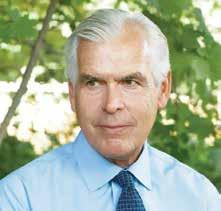
Philip Howard returns with a new book about government dysfunction and a bold recommendation for reform.
Philip K. Howard Howard believes one of the reasons that government has become so dysfunctional is because public employee unions – as opposed to elected officials – have too much control.
unions successfully blocked an increase in charter schools after several studies found that ‘these schools are producing spectacular gains’ and that ‘the effects are particularly large for disadvantaged students.’ Another union technique is to hurt existing charters in any way possible –such as fighting every decision to let charter schools use extra space in existing school buildings and reducing public funding per student below that of public schools.”
Howard makes clear that he is not opposed to unions. “What corrupts democracy is not the idea of unions,” he writes. “It’s not hard to imagine unions that actually promote better schools and greater efficiency.” But he ultimately concludes: “Constitutional government cannot withstand the organized political power of public employees who, in breach of their fiduciary duties, demand policies that harm the public … Political activity by public unions should be ruled unconstitutional. The Supreme Court need not create a broad loyalty doctrine. It only needs to hold that organized political activity by public employees involves an unavoidable conflict of interest with the core values of the Constitution: that officials should aspire to “promote general welfare” with “necessary and proper” laws and “take Care
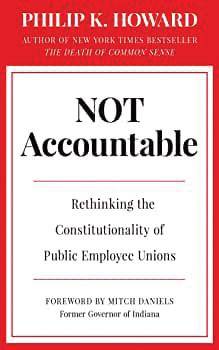
that the Laws be faithfully executed.”
Make no mistake – Howard’s recommendation is a bold one without precedent. But with trust in government at or near an all-time low and with a majority of the American public once again identifying government dysfunction as the top problem facing the country, one could easily argue that the time for half-measures is over. Former Indiana Governor and Purdue University President Mitch Daniels makes essentially this same point in the effusive introduction he penned for this book.
“If Mr. Howard is correct,” Daniels writes, “America does not need an aroused majority of millions to redress the corruption of our free institutions, only a judicial system willing to examine fairly the arguments of this learned fellow attorney and purely motivated public citizen. Let’s all hope Philip Howard gets his day, which would be a great day for all Americans in court.”
Until that day arrives, let’s hope all Americans hear more about Philip Howard and the latest book he has written about making government work. RF

At Netflix, we want to entertain the world. We’re streaming in more than 30 languages and 190 countries, because great stories can come from anywhere and be loved everywhere. We are the world’s biggest fans of entertainment, and we’re always looking to help you find your next favorite story.
The new 118th Congress convened last month amid searing speculation about what good will come out of it.

You guessed it: Congress is preordained to fail. There is every good reason in the gray matter of conventional thinking to accept that prognosis. Here are a few of them:
1) House Republicans have a thin 5-vote majority. The Senate has a very thin 2-vote majority. There are factions in both parties in both houses that could further destabilize that balance of power.
2) People are angry with and tired of the dysfunction of government and they have little faith in their representatives. They feel frozen out of Congress by partisanship, special interests, and a skewed electoral process.
3) Issues that were once problems are now grave crises that defy resolution in an ideologically polarized atmosphere and a gridlocked Congress.
4) The obsessive preoccupation with the 2024 presidential election will detour members of Congress and the media from public policy to public theater. There is a very important reason, among many, underlying those complaints. Americans are badly informed about how the government functions and how they can have more influence. They are drowning in a sea of misinformation, manipulative propaganda, just plain lying, and, most importantly, a sad lack of
education.
Some can’t name the three branches of government, or their congressman and senators, or the powers granted them in the First Amendment to the Constitution. They don’t know the rudiments of how a bill becomes a law or how to influence it.
Citizens are equally lacking in their knowledge of history. “Those who cannot remember the past are condemned to repeat it,” philosopher George Santayana reminded us 100 years ago.
Too many do not know the difference between the Declaration of Independence and the Constitution. A 2018 study by the Institute for Citizens and Scholars found that only 28 percent could name three of the original 13 states; 12 percent said Gen. Dwight Eisenhower fought in the Civil War. Only one in three Americans could pass a U.S. citizenship test. A 2019 survey of 41,000 Americans by the Woodrow Wilson Foundation found that only 27 percent of those under 45 had a basic knowledge of American history.
“Unfortunately, the…Foundation has validated what studies have shown for a century: Americans don’t possess the history knowledge they need to be informed and engaged citizens,” its President, Arthur Levine, said.
So why would anybody expect anything of value emanating from the Capitol? Good question, it but isn’t all doom and gloom.
Leaders who lead, and Committees that are allowed do all the work
New leadership on both sides of the aisle in the House offer prospects for some, if not much, bipartisan cooperation…Speaker of the House Kevin McCarthy receives the gavel from House Democratic Leader Hakeem Jeffries after being elected Speaker on January 7th.
New leadership on both sides of the aisle in the House offer prospects for some, if not much, bipartisan cooperation, less personal partisanship, and subdued vitriol, although the State of the Union did not exactly clear the air. House Republicans with a new majority have aspirations that can alter the prognosis in significant ways.
The widely scorned scrap to elect a Speaker should have short-term and long-term benefits. In the short-term, it may unify Republicans by bringing responsible factions to the table. In the long-run, it was a hop, skip, and a big jump toward congressional reforms that are badly needed to improve the productivity, fairness, openness, and responsiveness of the legislative process. Process reform has never had much sex appeal and the press ignores it, but these process changes will mean that critical issues will get the greater attention they deserve. They can put cracks in the gridlock.
An example: Among the first pieces of legislation to come before the new Congress was H.R. 21, a bill to restrict drawdowns on our Strategic Petroleum Reserve. It was brought to the Floor under the first open rule in seven years. That means members were actually able to legislate. More than 140 amendments were offered, there were nearly 50 roll call votes, and they finished in time for dinner.
That’s a big deal if Republicans allow more open and modified rules. It was a return to regular order, the time-honored procedures that have governed the flow of legislation and political behavior. Republican leaders are committed to restoring regular order in all committees. That, too, is a big deal.
There are by some counts over 200 full and sub committees — standing committees, select committees, special committees, joint committees and committees on committees. They are what former congressman Vin Weber calls the “indispensable obstacles to progress.” They may slow down action, but they are the lifeblood of the legislative process and when they are neutered by overbearing leaders, the blood drains and the legislative body is weakened.
It is in committees that partisans are more inclined to work together. It is in committees that the guts of issues are triaged in hearings, private deliberations, and real open debates. It is in committees where members become
experts and a resource for other members who have no time to learn the intricacies of complex subjects. It is where many problems can be resolved before they reach the Floor.
Committees are the workhorses that pull the plow that tills the soil that brings forth the fruit of political labor.
Restoring their rightful authority, with more balanced membership in the process is another big deal. There are many more major changes in store that may improve the appropriations process and prevent huge, unreadable bills.
Divided government actually can be more productive than the autocracy of one-party rule if leaders lead.
The Republicans’ problem is they still don’t effectively communicate to the public the importance of what they want to do and how they intend to accomplish it, setting aside the glittering generalities and divisive vitriol. True, much of it is the conspiratorial fault of the legacy media.
Another problem, maybe a crisis, is that good governance is extremely difficult without the trust and faith of engaged citizens. Good governance is supposedly what members of Congress signed up for — not good politics, but good governance. Public patience is gone.
Republicans and Democrats can help restore public trust by leading and by empowering the citizenry so they feel a sense of inclusion. The business guru Peter Drucker said once that, “No executive has ever suffered because his subordinates were strong and effective.”
No political leader will ever suffer because he or she has educated and informed the citizenry.
The public prognosis for this Congress does not have to be a self-fulfilling prophecy. RF
Mike Johnson is a former journalist who worked on the Ford White House staff and served as press secretary and chief of staff to House Republican Leader Bob Michel, prior to entering the private sector. He is coauthor of a book, Surviving Congress, a guide for congressional staff.

Republican leaders are committed to restoring regular order in all committees. That is a big deal.
Michael Johnson

PepsiCo is deeply committed to hiring veterans and active duty reservists as well as spouses and family members. We are proud to support the Ripon Forum and through programs like our annual Rolling Remembrance fundraiser supporting Fallen Patriots, we are engaged in building a culture that supports the needs of Veterans and military families.
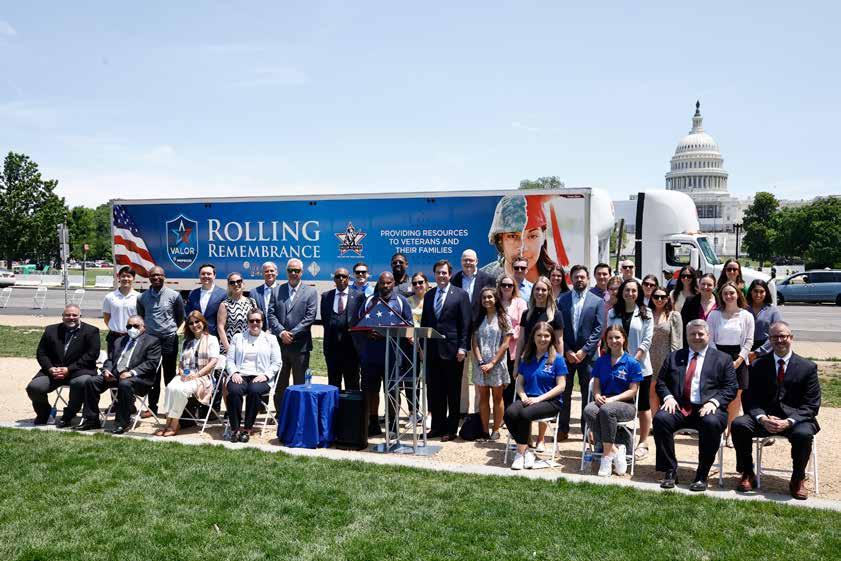
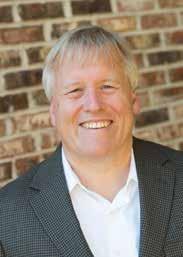 by JOHN PUDNER
by JOHN PUDNER
The Supreme Court’s greatest defender of free speech, Louis Brandeis, was also the Justice who proposed that states could serve as laboratories of democracy. It is a natural link. Americans have different opinions, states try different approaches, and we see what is effective — such as with national elections, which Article I of the Constitution gives states the powers to regulate.
Some laws and practices may not be the best fit for all fifty states, but when a law is successful for one state, it is not uncommon to see it spread throughout the country. One practice that is gaining traction is instant runoff voting, commonly known as ranked choice voting (RCV). The gist is voters can rank candidates according to their preference and save themselves time and money if a candidate wins less than fifty percent of the vote; instant runoff negates the need for costly and low-turnout runoff elections at some future date. Currently, Maine and Alaska are the two states to practice RCV state-wide, in addition to over fifty jurisdictions across the country which have adopted the electoral measure. In 2022, RCV was banned in Tennessee and Florida for state and local elections.
Another idea is a nonpartisan primary, which has been referred to by some press outlets as a “blanket primary,” and as an “all-party primary” in others. In these elections, all candidates run against each other at the same time. Republicans run against candidates from their own party, as well as against Democrats. As long as political parties maintain “their brand” by endorsing candidates through a convention or other means so the voters know which candidate more closely aligns with their views, this reform can shift power away from the elites and back to voters.
The election system that exists in most states historically offers voters only two candidates to choose from in November,
despite the many eager, civic-minded individuals who would like to run but can’t overcome the party primary-dominated model to get on the ballot. Thus, most voters are given a menu of one Democrat and one Republican, in what is increasingly becoming what conservative columnist Henry Olsen calls an “artificial forced choice between extremes.” It’s not uncommon to hear folks complain of selecting “the lesser of two evils.” Nonpartisan primaries and instant runoff voting implemented together — such as in Alaska, and which advanced this year to a final, up-or-down vote before the voters in Nevada in 2024 — can produce campaigns and election results that better reflect the political make-up of a community.
To take Alaska as an example: This unique voting system can help a legitimate independent or third-party candidate, but it also can help the political party that has a clear majority in an election but loses due to multiple “conservative” or “liberal” candidates splitting the vote to play spoiler. Alaska is thought of as a red state, and it is a fact that registered Republicans significantly outnumber registered Democrats. But outnumbering both of them combined is the more than 60 percent of Alaska voters who are independent or third-party. It is no surprise that a strongly conservative governor, a moderate Republican senator, and a Democratic House member from the Alaska Native community and with close ties to her Republican predecessor emerged this year from the new system.
In addition, nonpartisan primaries and instant runoff general elections put the average voter — who may lean one way or the other but doesn’t participate in the primary — at the center of the election process. Voters have a right to be skeptical of big government and establishment political party machines that might not represent the rank-and-file party members. We’ve
John Pudner
Some laws and practices may not be the best fit for all fifty states, but when a law is successful for one state, it is not uncommon to see it spread throughout the country.
seen party elites from both the GOP and Democratic Party handpick their preferred candidates down to the local level without involving party members in the process. Voters are tired of being told who to vote for by political insiders who are not accountable to voters. Reform-minded individuals are making use of the liberty provided by the Constitution to innovate the way they select their representatives to return the power of the ballot to voters — where it belongs.
Some Republicans are surprised when I tell them that I like the system that just went into effect in Alaska. But who likes it and who does not is not a simple matter of whether you are a Republican or a Democrat. The Democratic governor of Nevada opposes the idea in his state, for example, which exists as a tworound ballot measure — and the same voters who just threw him out in November advanced the measure from round one to a decisive vote in 2024.
True, a Democrat won Alaska’s House race — but as it has been observed widely, Sarah Palin was the only Alaska Republican whose unfavorable rating has been above 50 percent both nationally and in the state since 2010, which made her an unpopular first choice of voters and an unpalatable second choice of even many Republican voters who supported fellow Republican candidate Mark Begich. Republican voters were in a better position to “rank the red” in the Senate race, which featured two viable Republican contenders, and one of them ended up winning.
The state’s primary elections in August, in fact, resulted in nearly half of the general elections for state and federal office having multiple Republicans qualify for the ballot. What that means: In many races, Republicans are competing headto-head against other Republicans, allowing conservatives to break free of the old “left-right” paradigm and debate the nuances of conservative principles and which Republican candidate best embodies them. It does not make sense that a rural, conservative community should be forced to choose between a Democrat and a Republican when they can instead look past party labels and choose from among a wider group of candidates.
As Republicans, we often resist change for change’s sake. But we should keep an eye on what is happening in Alaska and Nevada and consider how other states approach elections. In his farewell address to Congress, George Washington warned of the dangers of sectionalism, including the dangers of political parties. While I will always be pro-Republican Party, Alaska gives us a chance to see how elections can return power to the people, creating an electoral system that better captures what the Founders had in mind. The party elites may not like it, but voters should consider taking a page out of Nevada and Alaska’s playbook and advocate for similar reform measures. RF
John Pudner is President of Take Back Our Republic Action Fund (www.takebackaction.org)Over the past year, President Biden has repeatedly attacked Republicans for a proposal by U.S. Sen. Rick Scott calling for a five-year sunset on all federal legislation. Such a provision, the President warned, could mean the end of Medicare and Social Security. But in making these attacks, the President is leaving out a small but notable detail — he once supported a version of sunset legislation himself.
The year was 1978. Jimmy Carter was President and Democrats controlled both chambers of Congress. In the Senate, the top legislative priority was passing S.1, a jobs bill aimed at easing unemployment, which stood at nearly 7.5 percent . The second most pressing priority — ahead even of a bill, S.3, aimed at reforming health care — was S.2, a bill to get spending under control by establishing a tenyear sunset provision for every federal program.
The bill’s main sponsor was Edmund Muskie, the legendary Democratic senator from Maine. Its supporters ranged from Republicans Barry Goldwater and Jesse Helms to Democrats George McGovern and Edward Kennedy. “ I regard the sunset concept as one of the most imaginative and innovative approaches to government reform that has been proposed in many years,” Kennedy said All told, S.2 had 59 cosponsors
in the Senate – 30 Democrats, 28 Republicans and one independent. The bill was overwhelmingly approved by a vote of 87-1 on October 11th.
While the bill was never voted on in the House and never seriously considered again, it is worth noting that one of the measure’s supporters was a firstterm Senator from the State of Delaware, who took to the Senate floor on the day of the vote to lay out why he supported a federal sunset law. “ When adopted,” then-Senator Joe Biden stated, “it will provide Congress with an essential tool for reviewing the need for Federal programs; controlling the growth of Federal spending; alleviating the overkill of regulatory activity; and restraining the sprawling Federal Bureaucracy.”
The junior senator then went on to explain how the sunset bill would work. “Simply stated,” he said, “the bill would terminate most Federal spending programs automatically on a regular schedule. Then, after a careful review by the appropriate Senate committee, the Senate and the Congress would decide whether to continue the program, or modify it, or terminate it. The two parts go together — the possibility of termination forces a review — and the review assures that the decision to continue or not continue the program will be a rational one. It is
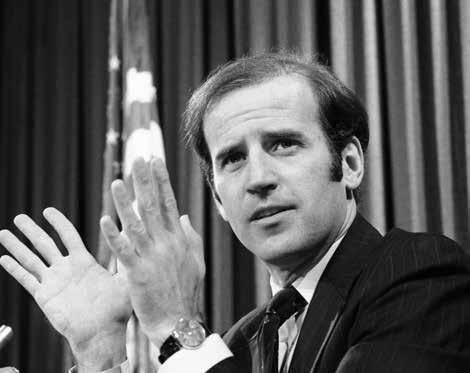
“When adopted,” then-Senator Joe Biden stated, “it will provide Congress with an essential tool for reviewing the need for Federal programs.”
really a very simple mechanism.”
Biden concluded his remarks by noting that he had been pushing for passage of sunset legislation since 1974, and with “the unacceptable prospect of a $100 billion increase in Federal spending over the next two years,” it was time for Congress to act. “ If we are not to remain in a deficit position forever,” he declared, “it is essential that we develop the tools to restrain spending. Four years of work has convinced me that sunset legislation is an essential tool. With the present rate of Federal spending, we cannot get it too soon.”
Over four decades later, Biden has apparently changed his tune when it comes to the need for federal sunset legislation. To be fair -- the bill he supported in 1978, S.2, exempted Social Security and Medicare from its sunsetting provisions. This exemption has given the President a window through which he can attack Scott’s proposal -- which, in reality, was not an expertly crafted bill but a rather poorly written bullet point.
But with the nation’s deficit over $1.5 trillion and with Congress once again hurtling toward a fiscal cliff over whether to increase the debt limit, it would be a good time to ask the President whether he would sign into law a bill similar to the one he praised and voted for 45 years ago – one that would sunset all federal programs except Social Security and Medicare in ten years as a way to get federal spending under control.
The idea is not that far-fetched. After all, sunset laws have been proven to work on the state level. A 2015 report by the Mercatus Center found that 36 states had some sort of sunset review process on the books. Texas has perhaps the nation’s most successful sunset program. According to a state government
website , “reviews conducted between 1982 and 2019 have had an estimated positive fiscal impact of $1 billion in state and federal savings and revenue gains, with a return of $19 for every $1 appropriated to the Sunset Commission since 1985.”
Moreover, the concept of reviewing federal programs to determine their efficiency and continued worth has public support. A 2017 survey of the American electorate by The Ripon Society bears this out. When asked if “Federal government programs should be subjected to regular performance reviews to ensure they are providing Americans with value for their tax dollars,” 94 percent of Americans said that they should. The poll also asked if federal regulations should have a sunset date “where they either end or Congress decides to renew them.” Nearly 80 percent of Americans said they should.

Make no mistake – a sunset law is not going to eliminate the nation’s debt and deficit on its own. Republicans and Democrats in Washington need to figure out a way to come together and reform entitlement spending for that to happen. But a sunset law will begin to change the culture in Washington by providing Congress with a “simple mechanism” to bring federal spending down.
Joe Biden once supported this kind of mechanism. Now that they control the House, Republicans should pass sunset legislation similar to what he voted for as a Senator in 1978 and see if he will sign it into law as President today. RF
Now that they control the House, Republicans should pass sunset legislation similar to what Biden voted for as a Senator in 1978 and see if he will sign it into law as President today.

For over 30 years, the ARDA-Resort Owners’ Coalition (ARDA–ROC) has championed causes on every regulatory and legislative level and this includes protecting owners from exit company scams and deceptive practices.
We are dedicated to providing essential resources and necessary information to help owners who want to exit their timeshare, avoid paying unnecessary fees or falling victim to deceptive or fraudulent exit schemes.

The Coalition for Responsible Exit was created to help timeshare owners learn about their safe and responsible timeshare exit options. If your resort or HOA is interested in joining the Coalition for Responsible Exit or if you want to discuss how to best share this information with your HOA Board, please e-mail rclements@arda.org
Visit www.responsibleexit.com
Whatever reforms they might propose, serious legal scholars understand that Section 230 includes the twenty-six words that created the Internet. Drafted by Rep. Chris Cox (R-CA), the law is exactly the kind of “forward-looking leadership” and “pragmatic” legislation the Ripon Society was founded to promote. Without Section 230’s protections, both providers and users of “interactive computer services” could be sued as the “publisher” of content they didn’t create – providers for hosting it and users for resharing or quoting it. Such lawsuits would be easy and cheap to file but many times more expensive to defend; and with billions of pieces of content posted each day, there would be an avalanche of them.

Some note that other countries seem to do well enough without Section 230. True, but none has anything like our legal system. In virtually every other democracy, the loser pays both sides’ costs of litigation. Not so in America, where defending against litigation is also uniquely expensive.
In the sorts of lawsuits websites would face routinely without Section 230, a defendant’s motion to dismiss a complaint routinely costs $15,000 - $80,000. Unless a judge grants such a motion, plaintiffs can compel defendants to produce extensive internal correspondence and witnesses. Battling over discovery can cost defendants hundreds of thousands of dollars.
A motion for summary judgment, usually prepared after discovery, can cost another $15,000 - $150,000. Trials cost much more. Juries regularly
award staggering damages, often based largely on their antipathy towards a defendant. Add to that the uniquely American proliferation of class actions, which multiply damage claims across tens or hundreds of millions of users. Considering all this, it is unsurprising that the U.S. has fifteen times more lawyers per capita than Canada. Truly, we live in a lawyer’s paradise.
Without Section 230, as one leading appellate judge (a Republican appointee) put it, websites would “face death by ten thousand duck-bites.” Most websites that host usergenerated content aren’t run by corporate titans; they’re small, community-based, or hobbyist endeavors, often nonprofits, with modest budgets and few lawyers. A single lawsuit would crush most of them.
Facing such costs routinely , who would ever risk liability for user-generated content? From blogs to podcasts, from Wikipedia to social networks, today’s user-driven Internet simply wouldn’t exist. Section 230’s unserious critics never acknowledge that the law protects all these services — and users — equally. They call the law a special subsidy for “Big Tech.” Those companies didn’t exist back in 1996 and they never would have gotten off the ground without Section 230. And who would use a social networking service? Would you retweet someone else’s content if you risked being sued for it? Ask President Donald Trump, who invoked Section 230 to dismiss just such a defamation lawsuit.
(cont’d on page 23)
Without Section 230’s protections, both providers and users of “interactive computer services” could be sued as the “publisher” of content they didn’t create...Berin Szóka
First – what is Section 230 and why should Americans care?

In a nutshell, Section 230 of the 1996 Communications Decency Act is America’s only policy and law governing conduct on the Internet
When Congress established “the policy of the United States” that the Internet and its services be “unfettered from Federal and State regulation,” the Internet was a bulletin board with dialup speed that was used by early adopters 30 minutes a month.
Section 230 was designed to encourage the buildout and adoption of the nascent Internet. It accomplished that objective. However, as the Internet matured, this policy resulted in many unintended consequences, including lost privacy , dishonest dealings , abuse of minors , extreme polarization , monopolizations , cyberattacks , and cybercrime .
Indeed, what some characterize as a ‘ Wild West ’ Internet policy has spawned way beyond simply minimizing regulation and a “hands-off” approach by government. Indeed, there is no rule of law, no policing to protect the public, and no accountability. This has resulted in a form of U.S.approached anarchism, which has been on autopilot since 1996. One could argue it has resulted in government-approved amoralism, which not only has minimal concern for right and wrong, but which denies the legal duty of care online that every American can expect offline.
Is Section 230 an ‘extreme machine’ of unintended consequences?
Yes! Most know one gets the behavior one tolerates and encourages. Inputs cause outputs, and the inaction permitted by Section 230 has created a swelling monsoon of unregulated and often illegal activity online. Section 230’s intent was:
-To “ ensure vigorous enforcement of criminal laws ” – the reality is less than .05% of cybercrime is prosecuted
-To promote decency online through the “ Communications Decency Act ” – the reality is indecent materials are rife online
-To have “ no effect on communications privacy law”— the reality is privacy is lost online
-To create “ a forum for a true diversity of political discourse, ” – the reality is lies, fakery, censorship, disinformation, polarization, hate , and violence , are rampant online.
-To “ empower parents to restrict their children’s access to inappropriate online material ” – the reality is there are no ageappropriate protections and there are more out-of-control indecent materials than one can imagine.
-To “ promote competition and reduce regulation ” – the reality is there are monopolizations and drastic degoverning.
(cont’d on next page)
As the Internet matured, this policy resulted in many unintended consequences, including lost privacy, dishonest dealings, abuse of minors, extreme polarization, monopolizations, cyberattacks, and cybercrime.Scott Cleland
Why repeal Section 230?
As the Internet evolves, so must the law and policy regarding it. Keeping Section 230 in place only paves the way for Big Tech to steamroll over elected officials, our judicial system, and any source of accountability. Here, I have identified the “Big 8” reasons why Section 230 must be repealed:
1) Unnecessary. Internet companies are free to buy private liability insurance or operate with reasonable care like everyone else has a legal duty to do. And they can innovate and compete based on reason, care, and integrity.
2) Antiquated. The U.S. has gone from being the world’s leader in setting Internet policy and law, to being the world’s laggard in 2023 and is the only major nation yet to modernize its policy on Internet conduct.
3) National Neglect. Section 230 addresses only one type of misconduct on the Internet – defamation liability for false statements – neglecting all other harms. As a result, five administrations, fourteen congresses, and seventeen Supreme Court justices, together, have neglected to protect America, Americans, and minors from all other online harms and crimes for 27 years!
4) Makes Big-Tech
Accountable. Section 230’s anarchic Internet policy is the Houdini superpower that enables Big-Tech to routinely escape responsibility for their actions and anticompetitive abuses. Over time, Section 230’s intermediary immunity law has in fact established an online regime of Big-Tech, by Big-Tech, for BigTech with impunity to censor, spread disinformation, and turn a blind eye to incitement, hate, and violence. Privileged treatment causes polarization that undermines democracy and divides the nation.
5) Depolarizing. Repeal is the only constitutional, fair, and accountable solution for Big-Tech/social media’s out-of-control intermediary impunity. A rewrite of Section 230 would put Congress in the position of adjudicating the Bill of Rights. Only repeal prevents Congress from facilitating censorship and the spread of disinformation.
6) Willful Blindness. Most of Big-Tech and its paid proponents plead Section 230 is an Internet essential that harms no one. Their scripted silence about Section 230’s many harms hiding in plain sight is, at best, a collective half-truth, and at worst, widespread willful blindness. Research and evidence by the Restore Us Institute actually reveals that America and Americans are worse off now than before the ‘Wild West’ Internet. The fact is Section 230 has subverted the Constitution, public safety, national security, justice, religion, and liberties/rights
7) Internet Injustice. Today, Congress’ Section 230 precedents disenfranchise the civil judiciary’s adjudication of Internet illegal conduct cases to legitimately determine truth-lies, fair-unfair, and legal-illegal. Instead, Congress has unreasonably empowered random unvetted private actors with immunity to mediate all of Americans’ interactions arbitrarily for profit, surveillance, politics, power, and dominance.
8) Existential Enemy. Government officials have sworn to “defend the Constitution…against all enemies…” Section 230 is an existential enemy of the Constitution because it subverts the government’s sovereignty, authority, and purposes.
Yes. The repeal ends any notion the U.S. Internet is separate from America, and will intentionally restore the ideal that no one or nothing is above the law or outside governing authorities.
Repeal purposefully restores America’s government “of the people, by the people, for the people,” in intentionally restoring this primacy of people. It will help prioritize humanity over technology and people over profit, and recognize the need to protect minors over adults.
Repeal is not regulation. Repeal of Section 230 removes the Internet as a space free from the rule of law; it allows the laws of the nation to apply to the Internet, thus subjecting all players to the appropriate governing authorities. Repeal ends special treatment online. Repeal will pave the way for the same rules and rights everyone holds offline to be upheld online. Those acting illegally online are held accountable just as those acting illegally offline are. Unprotected speech offline is unprotected speech online. Repeal of Section 230 is the only way to pursue “Equal justice under law.” RF
Scott Cleland is Executive Director of the Restore Us Institute (RUI), an Internet policy think tank and nonpartisan, faith-based nonprofit with a mission to restore Internet accountability to protect people from online harm. Cleland was Deputy U.S. Coordinator for International Communications and information Policy in the George H.W. Bush Administration. To learn more, visit www. RestoreUsInstitute.org and www.ScottCleland.com.
Over time, Section 230’s intermediary immunity law has in fact established an online regime of Big-Tech, by Big-Tech, for Big-Tech with impunity to censor, spread disinformation, and turn a blind eye to incitement, hate, and violence. Privileged polarization destroys democracy and makes a nation divided that cannot stand.
Websites that somehow survived such risks would have a perverse incentive to take down content whenever anyone complained, creating a heckler’s veto. Many would ban vast swathes of controversial content preemptively. A few might even try to vet all user comments. That would make real-time engagement impossible and couldn’t scale to millions of users. In short, those who complain of “Big Tech censorship” would unwittingly create more of the same.
On other sites, especially those with fewer resources, abuse would flourish. In the early 1990s, U.S. courts began deciding cases involving online defamation. Moderating harmful content actually made websites more liable for it, as did proactively monitoring user content or letting users flag potentially unlawful content. Section 230 neatly avoided this Moderator’s Dilemma by insulating even imperfect content moderation from liability.
There’s always a balance to be struck in moderating harmful content and allowing user expression. Other democratic countries ban misinformation, hate speech, speech encouraging violence and self-harm, and more. But our First Amendment protects much of what would be illegal elsewhere. Requiring websites to assess the lawfulness of user-generated content would tilt the balance further from the First Amendment: websites would remove any content a court might conceivably declare unlawful, just to be safe.
The First Amendment allows each site to strike its own balance in moderating “lawful but awful” content. But that right would mean little if each site had to constantly relitigate the precise boundaries of the First Amendment’s protection, especially in borderline cases. Section 230 makes that protection meaningful by streamlining what could be staggeringly expensive, fact-intensive litigation. Today, when a website is sued for refusing to carry content it abhors, it can easily and cheaply win a motion to dismiss under Section 230. This isn’t just tort reform: it protects against the abuse of courts to punish the exercise of First Amendment rights— something populists, especially state attorneys general, are increasingly eager to do.
Some insist new media don’t have the same
First Amendment rights as traditional media. But as Justice Antonin Scalia put it, “the basic principles of freedom of speech and the press, like the First Amendment’s command, do not vary when a new and different medium for communication appears.” Parade organizers, newspapers, and other publishers clearly have the right to refuse to carry others’ content. If the Supreme Court takes on such questions next year, expect it to uphold a unanimous panel of the Eleventh Circuit — all Republican appointees — in protecting the editorial judgments of websites.
Some critics have called Section 230 “America’s Internet competition law.” But a competition claim can proceed against a tech company, ruled one court, if it “seeks to hold Defendants liable solely for their own conduct, not anyone else’s.” In how a company deals with third-party content, Section 230 protects only editorial judgments, not anticompetitive business practices — a distinction long acknowledged by the Supreme Court in applying the antitrust laws to media companies. What these critics really want to punish tech companies for, their alleged political bias, is exactly what the First Amendment protects.
Most complaints about the Internet aren’t really about Section 230 at all. Competition law can address real economic harms. Federal privacy legislation is long overdue — and closer to enactment than ever before. Federal criminal law, like intellectual property, has always been excluded from Section 230. Increased funding for federal law enforcement would help, and Congress can always enact new criminal laws without touching 230.
Can Section 230 be improved? Perhaps. The Ripon Society’s 1963 founding manifesto called for a “mature Republican philosophy... concerned more with the complexities of the means toward a solution than with a simplistic view of the ends.” For a serious debate about Section 230, listen to the scholars, not the polemicists. Read more law review articles, legal briefs, and thoughtful legislative hearings. And, please, fewer op-eds. RF
Berin Szóka is President of TechFreedom, a non-profit think tank dedicated to technology law and policy. He has practiced Internet and communications law since 2005.
Most websites that host user-generated content aren’t run by corporate titans; they’re small, community-based, or hobbyist endeavors, often nonprofits, with modest budgets and few lawyers. A single lawsuit would crush most of them.

WASHINGTON, DC – In remarks on February 8th before a breakfast meeting of The Ripon Society, three new members of the Ways & Means Committee discussed their new roles on the influential tax writing panel and some of the priorities they plan to work toward in the coming year.
The members were: Randy Feenstra, who represents the 4th District of Iowa in the U.S. House of Representatives and was elected to Congress in 2020; Blake Moore, who represents the 1st District of Utah and was also elected to the House in 2020; and, Mike Carey, who represents the 15th District of Ohio and was elected to the House
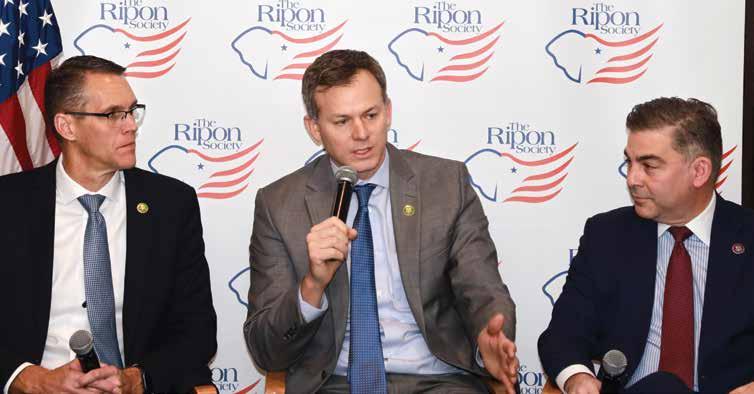
in a special election in November 2021.
“Being on Ways and Means is an honor,” stated Feenstra, who kicked off the discussion and opened his remarks by noting that he served as Chair of the Ways & Means Committee in Iowa when he was a member of the state Senate. Pointing to priorities that the Committee will be focusing on in the coming year, he said he thought addressing some of the sunsetting provisions included in the Tax Cuts and Jobs Act would be at or near the top of the list, particularly as they relate to one-time expensing and bonus appreciation.
“As we try to grow economically,”
he observed, “both in research & development and in manufacturing technology, those things going away is really big.”
The Iowa Republican also thought trade would be a priority on Ways & Means this year.
“It came out this past week that we’re at a $948 billion trade deficit, which is huge” he noted. “Of that, you have China exporting to our country $538 billion, and we’re exporting to China $131 billion. So we’ve got a lot of work to do in the trade area. I look forward to that and I obviously look forward to working with these gentlemen.”
Moore echoed his colleague’s remarks.
“I am excited to be on this committee,” he stated. Referring to the broad jurisdiction of Ways & Means and how it affects Americans – and Utahns — in all walks of life, he added: “You go to one of your first town halls and you realize that there are 17 things that people are concerned about, all of which you may or may not have any control over.”
One thing the people he represents are concerned about, Moore said, is the debt and deficit and the need to get spending under control in Washington, DC.
“We’re a state that has been so responsible,” he remarked. “We see the value of economic growth. We see the value of low taxes and of creating opportunities for businesses and people. That’s what drove me to be in this role on Ways and Means.”
The Ogden native is the first Republican Member from Utah to hold a seat on the Ways & Means Committee, and he said he plans to represent not only his district, but the values of the entire Beehive State in this new role.
“Utah’s never had a Republican Member on the House Ways & Means Committee,” he noted. “We had one Democrat in the ‘60s for one term. So we have not had representation on this, all the while we are such a model for the nation as far as how to grow a diverse economy, how to keep
taxes in check, and embrace the social aspect of doing right by those that are in need. It’s built into our culture. I go back and I talk about in Utah wanting to take Utah values to Washington. It’s a great bumper sticker, and this is an opportunity for me to do so.”
“We see the value of economic growth. We see the value of low taxes and of creating opportunities
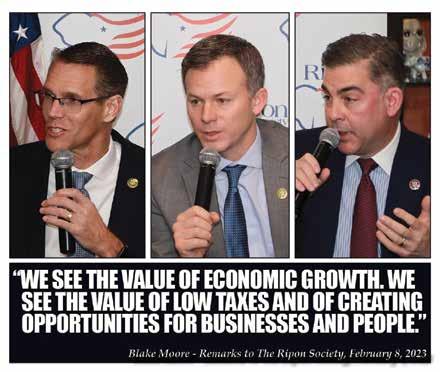
Ways & Means Committee, and the tradition that members from the Buckeye State have on working across the aisle.
“Ohio has had a long tradition of having two members on Ways and Means,” he stated. “You go back to the time of Pat Tiberi, and obviously Jim Renacci, and then of course with Brad [Wenstrup], and you look at Ohio’s delegation for many, many years. We had some real champions in Ohio.”
“The nice thing about the Ohio delegation — and I think you’ll see this across-the-board with the members on this committee – is that we have a really good history of reaching across the aisle.”
for businesses and people.”
Moore closed his remarks by touching on one of his broader goals as a Ways & Means member in the coming years.
“The way I will view success over the next several terms, if I’m fortunate to be reelected, is, am I able to bend that debt-to-GDP curve down? Am I going to be a part of not adding so much onto my kids’ debt? That’s something that I’m passionate about. And to be able to be on this committee working now on our nation’s biggest issue, it’s a real honor.
Carey concurred, and opened his remarks by talking about the historic role of Ohioans on the
Carey also gave high marks to the new Chairman of the Committee, Jason Smith (MO-8), and the staff he has brought on board.
“I think he’s doing a phenomenal job,” he stated. “He’s moved many of his staff over from the Budget Committee to the Ways and Means Committee … and that staff is just amazing.”
Carey also praised Smith’s plan to hold field hearings around the country.
“I don’t know where they’re all going to be,” he said, “but I’m going to tell you that it’s going to give us the opportunity to speak with real Americans in the Heartland, and on the coast, and everywhere in between. So I really appreciate the opportunity to be on this committe.” RF






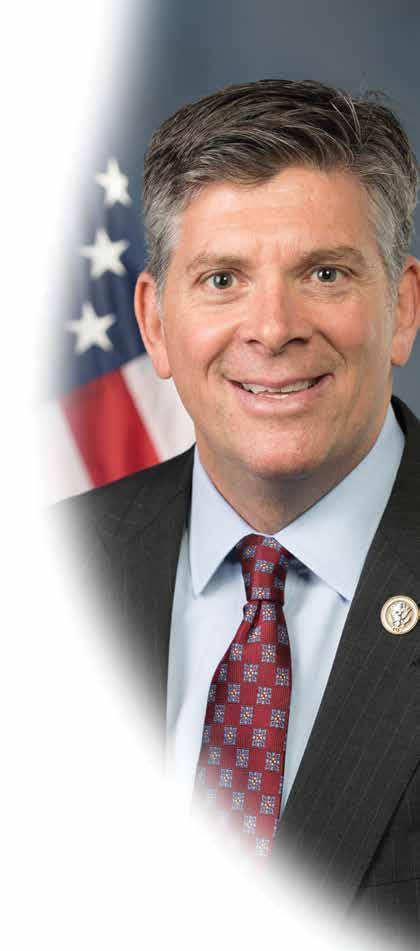
Occupation: U.S. Representative, 16th Congressional District of Illinois
You’ve been in office for eight years now. What’s been the toughest part of the job during that time? Undoubtedly, the COVID-19 pandemic and the state-mandated closures brought forth unprecedented challenges for our country and our communities in Illinois. Small businesses, schools, and our everyday lives were ground to a halt. Even in the Capitol, work largely became remote and we all had to learn to adapt, but still support the American people, provide constituent service, and legislate effectively. I am proud that Congress was able to rise to the challenge and support the needs of our constituents, but I am glad that we are now fully reopen, legislating in person, and conducting the business the American people sent us here to accomplish.
And the most rewarding part? Is there a victory or experience you’ve had that made it especially worthwhile? One of the most rewarding parts of my job is getting to help people every day in Illinois through our casework and constituent services. Providing high quality constituent services and communication is one of the most important things we do as a Member of Congress. Whether it’s veterans’ issues or helping constituents navigate the IRS or Social Security Administration, it is incredibly rewarding to assist folks in Illinois who need support from the federal government.
Additionally, I really have enjoyed being a member of the House Intelligence Committee for the past two years. Working with the brave men and women who protect our nation in our Armed Forces and Intelligence Community makes our work incredibly rewarding.
What are your top three legislative priorities in the 118th Congress? As Chairman of the Ways & Means Subcommittee on Work and Welfare, I will prioritize policies that strengthen child and family care, ensure effective and accountable use of taxpayer money, reinvigorate our workforce, and address the rampant COVID-era unemployment fraud.
I was also appointed to the Select Committee on the Chinese Communist Party (CCP). The CCP is a strategic competitor and presents growing economic and military challenges to the United States. Now more than ever, Congress must work in a bipartisan way to strengthen American economic competitiveness, bolster and secure our supply chains, promote our trade interests and leadership in the Indo-Pacific, modernize our technology, and protect our national and cyber security against China.
Lastly, I will prioritize policies that strengthen our agriculture communities in Illinois and support our farmers. With upcoming Farm Bill negotiations, I will advocate for policies that support Illinois farmers and bolster trade opportunities through my work on the Ways and Means Trade Subcommittee.
As the father to three young men, what would you like your children to remember about this moment in history? When my boys grow up and reflect back on this time in history, I hope they remember that we are Americans first, above all else. Despite our differences, we should always look to see the best in others and when we work together anything is possible in this country.
Homeownership creates jobs, empowers families and strengthens communities.






















At AstraZeneca, we’re pushing the limits of science through our Ambition Zero Carbon strategy to deliver net zero healthcare, manage our environmental impact and invest in nature. By reducing carbon emissions, harnessing sustainable green energy and working toward a 100% green fleet, we’re championing sustainability for a healthy planet, healthy people and a healthy society.
At AstraZeneca, we’re pushing the limits of science through our Ambition Zero Carbon strategy to deliver net zero healthcare, manage our environmental impact and invest in nature. By reducing carbon emissions, harnessing sustainable green energy and working toward a 100% green fleet, we’re championing sustainability for a healthy planet, healthy people and a healthy society.
AstraZeneca is a proud supporter of the Ripon Society.
AstraZeneca is a proud supporter of the Ripon Society.

